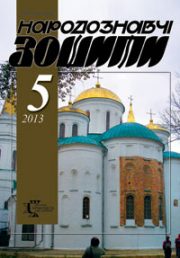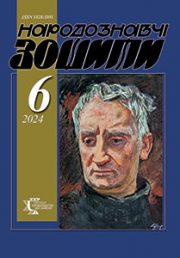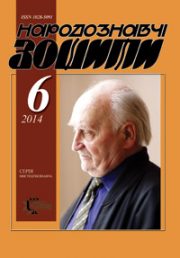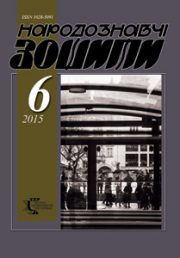The Ethnology Notebooks, 2018, № 5 (143), 1149—1160
UDK 745.52:747 ”1920/1980”(091)
DOI https://doi.org/10.15407/nz2018.05.1149
Received 29.06.2018
CARPETS AND RUGS IN HOUSING INTERIOR AS ELEMENTS OF THE SOVIET LIFE CULTURE
ORCID ID https://orcid.org/0000-0003-0340-5436
Jamborko Olha, Candidate of Sciences in Art Studies,
Associate Professor of the department of design and theory of art,
teacher of Institute of arts of the Prykarpattya national university
of the name of Vasyl Stefanyk.
Street of Shevchenko, 57, Ivano-Frankivsk, Ivano-Frankivsk area, 76000
Contacts: tel. 067 139 14 78, e-mail: kalyna015@gmail.com
Abstrakt. The article deals with the use of carpets in the interiors of the Soviet era at various stages of its historical development. The factors influencing the aesthetics and style of typical dwelling interiors are highlighted, the artistic compositional features of their subject environment are considered. The main attention is paid to the study of the semantic status of the carpet in the culture of everyday life of the urban population of the 1920’s and 1980’s, and the formation of related key social practices. The place and role of carpets of Ukrainian production in these processes are found out.
Keywords: carpet, life culture, dwelling interior, social practices.
REFERENCES
Vil’kovskij, M. (2010). Sociology of Architecture. Moscow: Russkij avangard [in Russian].
Holod, I. (2016). Artistic treatment of wood and furniture. In G., Skrypnyk (Ed.). History of decorative art of Ukraine (Vol. 5, pp. 213—222). Kyiv: National Academy of Sciences of Ukraine [in Ukrainian].
Honcharyk, R. (2017). Features of architectural and spatial changes of Ivano-Frankivsk in the Soviet period. Modern Problems of Architecture and Urban Development, 47, 249—264 [in Ukrainian].
Gudova, M. (2009). Soviet chic and Russian glamor: values and representations. In Kupina, N.A., & Mihajlova, O.A. (Eds.). Soviet past and culture of the present (Vol. 2, pp. 39—54). Ekaterinburg: Izd-stvo Ural’skogo un-ta [in Russian].
Degot’, E. (2005). From goods to a friend: To the aesthetics of a non-market object. Logos, 5 (50), 201—210 [in Russian].
Zhilina, L., & Frolova, N. (1969). Problems of consumption and personal education. Moscow: Mysl’ [in Russian].
Zhuk, A. (1985). Regional features of the Ukrainian carpet. In Artistic crafts: theory and practice (pp. 22—35). Kyiv: Naukova dumka [in Ukrainian].
Il’in, M. (1976). Tradition, nationality, innovation. In M.A., Il’in (Ed.), Selected Works on the Art of Folk Crafts and Architectural Heritage of the 16th – 20th Centuries: Studies and Essays. Moscow: Sovetskij hudozhnik [in Russian].
Klinova, M. (2014). Soviet fashionable discourse of the second half of the 1970s-1980s: evolution of the transmitted consumer strategies. Bulletin of Perm University: History, 4 (27), 140-150 [in Russian].
Kolos, S., & Khurhin, M. (1949). Decorative fabrics. Kyiv: Vyd-vo Akademiyi arkhitektury URSR [in Ukrainian].
Kosmina, T. (2008). Folk Art in the Architectural Ensemble of People’s Housing. Ukrayinsʹke mystetstvoznavstvo: materialy, doslidzhennya, retsenziyi, 8, 52—62 [in Ukrainian].
Levykin, I., & Pokrovskaja, M. (1984). Problems of the level and quality of life of Soviet people. In I.T., Levykin M.V, Pokrovskaja (Eds.), Soviet way of life: The state, opinions and assessments of Soviet people. Moscow [in Russian].
Lukovsʹka, O. (2007). Lviv’s artistic weaving of the second half of the twentieth century: artistic features, traditions and innovations. (Ph.D diss.abstr.). Lʹviv [in Ukrainian].
Ljubimova, G. (1974). Limits of the variability of living space. Arkhitektura SSSR, 7, 6—8 [in Russian].
The speech of Comrade Stalin at the First All-Union Conference of Stakhanovites. (1935). Rabotnica, 20, 3—4 [in Russian].
Samoylovych, V. (1972). Ukrainian folk dwelling: the end of the XIX — the beginning of XX century. Kyiv: Naukova dumka [in Ukrainian].
Smolensʹka, S. (2017). Architecture of avant-garde modernism in Ukraine: genesis and heritage. The thesis for obtaining sciences. Ph.D. degree of architecture. Lviv: Polytechnic National University [in Ukrainian].
Astrahanceva, T. (Ed.). (2010). The style of the great era: Album-catalog of the exhibition “Victory. Style of the era”. Moscow: ArsisBooks [in Russian].
Usanova, A. (2016). Artistic and domestic traditions in the Soviet urban interior: 1930—1950-ies.(Doctoral diss. abstract). Altai State University. Barnaul [in Ukrainian].
Utekhin, I. (2001). Essays on communal life. Moscow [in Russian].
Chehusova, Z., Kara-Vasylʹyeva, T., & Prydatko, T. (2008). Lyudmyla Zhoholʹ: The Fairy of the Art Textile. Kyiv: Lybid [in Ukrainan].
Shust, V. (1974). Interior of the apartment of mass construction. Arhitektura SSSR, 7, pp. 3—6 [in Russian].
Gurova, O. (2005). From everyday asceticism to the cult of things: the ideology of consumption in Soviet society. In People and things in Soviet and post-Soviet culture: Sat. articles (pp. 6—21). Novosibirsk: Izd-vo NGU. Retrieved from: http://ecsocman.hse.ru/text/19198252/ [in Russian].
Deykhina, Ye. (2005). From repair to interior design: the transformation of personal living space in Soviet and post-Soviet Russia. In People and things in Soviet and post-Soviet culture: Sat. articles (pp. 77—92). Novosibirsk: Izd-vo NGU. Retrieved from: http://ecsocman.hse.ru/text/19198252/ [in Russian].
Yechevskaya, O. (2005). “Freedom in things” and “freedom from things”: the meanings of things in the practices of everyday life. In People and things in Soviet and post-Soviet culture: Sat. articles (pp. 49—66). Novosibirsk: Izd-vo NGU. Retrieved from: http://ecsocman.hse.ru/text/19198252/ [in Russian].
Osipchuk, I. (2013). Lyudmila Zhogol’: “For the creation of the interiors of the hotel “Kyiv” I was awarded a prize of 16 rubles and an internship in Italy”. Facts. Retrieved from: http://fakty.ua/158858.
Turko, Kh. The role of Lviv House of Models and Weaving Workshop at the regional branch of the Ukrainian Artistic Art Fund in the revival and development of traditional handmade weaving in Lviv. Retrieved from: http://intkonf.org/turko-hv-rol-lvivskogo [in Ukrainian].
Turlik’jan, T. (20.02.2017). Soiet «babushatnik». Cablook. Retrieved from: http://www.cablook.com/inspiration/sovetskij-babushatnik-ot-stalinskih-servizov-do-kitajskogo-miksera/ [in Russian].







